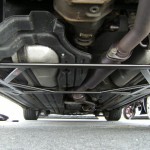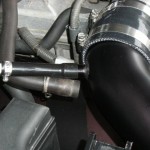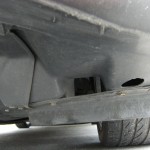Popular Posts
- Don't Block or Remove the EGR Valve, It's Saving You Money
- Keep Your Engine Alive: The Importance of Oil Temperature
- Low Temp Thermostats: What's the Advantage?
- Wheel Tech, Part III: Wheel Diameter's Effect on Performance
- Beating the Heat: Advantage of a High Pressure Radiator Cap
- How to Compare Weight Savings to Horsepower Gains
- Check Your Engine's Health: With a Vacuum Gauge
- Wheel Tech, Part II: Width Matters
- What's So Wrong With Nitrous?
- Stiff Stuff: Strut Bars and Braces
Resources & Classes
-
Yearly Archives: 2011
Stiff Stuff: Strut Bars and Braces
No matter what car you drive, there are a number of suspension braces available  to supposedly improve handling. People shell out hundreds, even thousands of dollars on strut bars, under body braces, suspension member braces, fender braces, and frankly braces that attach to just about anything that has a bolt in it.
to supposedly improve handling. People shell out hundreds, even thousands of dollars on strut bars, under body braces, suspension member braces, fender braces, and frankly braces that attach to just about anything that has a bolt in it.
But what do these bars really do, if anything? Are all braces the same or are there important differences between them?
In today's article, I hope to begin to decode a little bit about each of these extremely important questions. While everyone just assumes they wouldn't be so popular if they didn't "work", I am here to tell you that there are far more bad products on the market than good ones - especially when it comes to chassis braces.
I am going to limit my discussion here to strut braces as they are generally the most effective and common. However, aside from placement, all other braces you can fit to your car are going to have a similar function. (more…)
Posted in Braking & Handling
4 Comments
Clever Tricks for Improving the Location and Height of The Center of Gravity
Most enthusiasts are aware that lowering a car's center of gravity is good for handling and indeed, grip.
It's easy to see the real world implications as well when we think about how a tall SUV handles versus a very low Ferrari or Corvette.
Where the Center of Gravity Is
The car's center of gravity has both a horizontal (x, y) and vertical (z) location and actually refers to a single point where if suspended, the car would balance perfectly (at least in theory).
So vertically, we already know that the lower the center of gravity - the better. What about horizontally? Well, again, take a look at super cars - the closer weight is to the center of the vehicle the better. This is why super cars are typically mid-engine, so the heaviest part of the car (the engine/transmission) is closer to the middle of the vehicle.
The center of gravity in most cars is roughly at the top of the front bumper in terms of height (just a very rough estimate). The (x,y) coordinate of the center of gravity is much more variable, the Y being affected by the car's front and rear weight distribution. So in most cases, the CoG is at bumper height, somewhere in front of the midline of the car as you look at it from the side of the car. As you look from the front of the car, it is going to be either in the driver or the passenger's lap as most cars are slightly heavier on one side or the other.
Improving Center of Gravity - Vertically
Lowering a car is one way to improve the vertical center of gravity. This will offer increased stability, lessen the risk of roll over in extreme situations, and in most cases increase lateral grip (or the "g" handling figures on the skid pad). There are practical limits on how low you can go due to road imperfections and so on. There are also limits on how low you can go on a factory suspension without actually hurting handling. Usually around an inch of lowering is the farthest you can go without serious changes to your suspension geometry... but more on that in another article.
Vertical CoG can be improved by removing weight or choosing not to locate weight high in the vehicle. You can also get a CoG advantage from choosing a vehicle without a sunroof. Sunroofs in modern cars are around 25-30lbs, but in older vehicles they were sometimes 40-60lbs. In any case, take note that BMW thought it worth the exceptional expense to use a carbon fiber roof on many of their M vehicles. A few pounds on the roof of a vehicle can make a significant difference on the track, and 10-15 lbs can make a noticeable difference even on mountain roads.Having removed the sunroof on a car before, I can say that removal is not ideal (reasonably expensive) and you'll be better off to start with a car without a sunroof if possible.
Posted in Braking & Handling
2 Comments
How much Horsepower Can My Engine Make?
Without adding forced induction, many people want to know how much horsepower their car can make. Typically there's some pretty wild theories about how to get there and what that figure might be. However, there's a very straight forward way to figure out the theoretical maximum for your street car (as long as boost is not involved).
Volumetric efficiency is a term that (basically) refers to the ability of an engine to convert air and fuel into power. More accurately, it's the engine's ability to make use of the available air around it.
Posted in Engine
3 Comments
A Better Way to Compare & Anaylze Engine Efficiency
People often talk about horsepower per liter when they're comparing two engines. For example, you might say that the JDM B18C engine in the Integra Type-R produced 210hp from 1.8 or an impressive ~ 117 hp per liter. You may then be tempted to look at an engine like the 2JZ-GE found in project Lexus and scoff at it's 215hp from 3.0L, which is a mere ~ 72 hp per liter. Many IS300 owners are previous Honda guys, so, naturally, this is a very common 'scoff' :).
However, there is a better method to compare two engines (and also figure out how 'developed' an engine already is) which while also with its faults will give you a much better idea of what you're dealing with.
BMEP is one of many figures that you can use to compare engines. It stands for Brake Mean Effective Pressure and it refers to the amount of average pressure generated on the piston during combustion. BMEP gives us a much better idea of how 'developed' an engine is, how much stress/pressure is on the engine internals, and to some degree, how effective that engine is at converting gasoline to power. While this article mostly deals with Naturally Aspirated engines, it can also be used on forced induction engines - however, note that the BMEP values for these engines will be much much higher.
Posted in Engine
9 Comments
The 5 Best Bang for Your Buck Mods
If I could do only 5 performance modifications to a car, with cost being a consideration, and perhaps also wanting to strongly avoid "ruining" the car, what would I do?
Posted in Braking & Handling, Engine
4 Comments
Ingenious Designs: OEM Brake Ducts
A lot of car guys give the OEMs a pretty underwhelming amount of credit. However, I think what they fail to remember is that the original manufacturer, while concerned with many things we typically are not concerned too much with (noise/harshness/cost/etc), spends more money designing the heater knob in your car than most aftermarket part companies make in a decade. Seriously, they're that serious (especially the Japanese and Germans!)
In other words, despite there being some very clever tuners out there, the OEMs are usually FAR more clever (and better funded/resourced) than we give them credit for - and thus, in the right cars, they can be a great source of inspiration.
Older cars and slower cars can always look to newer and faster cars for great ideas. In this article, I'm going to show you how you can look to ingenious OEM designs to improve your own car.
Discovery
While working on Project Lexus, I was thinking about putting together an article on a cheap brake upgrade in the form of brake ducts. We'll probably do something on that in the future, but while doing a bit of research, I noticed that the IS300 actually already has brake ducts - and some rather clever ones at that!
They actually have implemented them in a way that many of you can replicate to reduce drag AND get some really effective brake cooling in the process. (more…)
Posted in Braking & Handling
Comments Off on Ingenious Designs: OEM Brake Ducts
Beating the Heat: Advantage of a High Pressure Radiator Cap
 Spoon, Mugen, TRD, and about two dozen other 'big name' companies all sell these "High Pressure" radiator caps. However, if you ask the average person what they actually do, you'll be met with cricket chirps.
Spoon, Mugen, TRD, and about two dozen other 'big name' companies all sell these "High Pressure" radiator caps. However, if you ask the average person what they actually do, you'll be met with cricket chirps.
Most imports use 1.1 kg/cm2 radiator caps while these aftermarket pieces are typically 1.3 kg/cm2. These caps are also available for domestics and some exotics as well, but the same principle applies regardless of the make/model of car. Sometimes they are rated in the "bar" unit. The conversion factor is 1.02, so for the purposes of this article, because kg/cm2 is more awkward to write, I will say 1.1 bar and 1.3 bar. 1.1 bar is nearly exactly equal to 1.1 kg/cm^2. So, yes, I realize import caps are rated in the metric unit, but I'm going to use bar instead to make my writing a little easier.
These caps look cool, and they're sold by big names - but let's look at what they actually do and why you may or may not want one. (more…)
Posted in Engine
3 Comments
Intelligent Modification: Doing Some Intake Mods on Project Lexus
 Last time I showed you how I measured the intake restriction on project Lexus. Hopefully seeing how easy it is done has now inspired you to go out and take some measurements of your own.
Last time I showed you how I measured the intake restriction on project Lexus. Hopefully seeing how easy it is done has now inspired you to go out and take some measurements of your own.
Let's Review
So before we get started, let me quickly review some of what we learned in the past two articles. First of all, we discussed how you can use a vacuum gauge or differential pressure meter to measure intake restriction.
I then showed you on the IS300 exactly how I tapped the intake system in various places to determine where the intake restriction was. Anywhere I tapped the intake system I knew that the restriction from that point FORWARD (towards the front of the intake system - ie the snorkel and in fact, the open atmosphere).
I also told you that, surprisingly, the IS300s intake system is actually quite good even in completely stock form. The total pressure drop on this car, with a bone stock intake system was only -9.1 inches of water (among one of the better stock systems I've measured). This pressure drop was measured on a previously modified engine as well. This means that if anything, the pressure drop on our car would be higher than or equal to the stock car. I suspect it would be the same. (more…)
Posted in Engine
3 Comments

